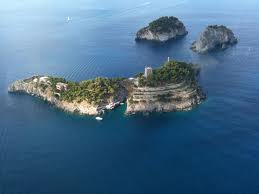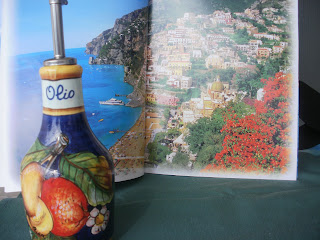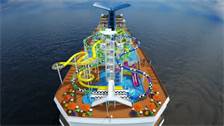 |
| At the Amalfi Coast |
Naples came into view as dawn ushered in the day. We had planned a "Fun Ashore" excursion that would take the whole day. So we got up early and had breakfast delivered to our room. Then we went down to the Liquid Lounge at 7:45, turned in our tickets and got a red sticker with a number 10 to stick on our shirt. Then we looked for an available seat in the crowded auditorium and waited for our numbered to be called. The room was full of people who would be taking one of nineteen tours that were offered by the ship. There were tours to Sorento, local wineries, Pompey, Amalfi Coast, Isle of Capri, and a climb to Mt. Vesuvius just to name a few. We had planned a ride to the Amalfi coast where we would have lunch and then in the afternoon proceed to Pompeii.
 |
| Naples at dawn |
Our tour guide introduced herself as "Angelina" and said that we would all be her, big, happy family. To be in her charge we would have to obey, do as we were told, and above all stay together. She showed us her "Popsicle Stick" sign with a number 10, and told us to always stay behind the sign when we were touring. She introduced our driver as Paolo and said he was the best driver of the fleet. She informed us that we would be driving for about an hour and then we would stop and have a bathroom break.
We began the drive out of the city and headed for the coast. The highway built in 1815 by Ferdinand II of Bourbon is known as the "Nastro Azzuro" (Blue Ribbon) because it hugs the coast line, and the blue sea is always in sight. It was very narrow with lots of hair pin turns that were difficult for our large bus to navigate. This was especially true if there was an on coming car coming the other directon. What happened on several occasions was that the on coming car had to back up enough to allow the bus to make the turn. For this reason the large tour buses can only go one way from west to east. Luckily, everyone goes slowly enough, so that even on blind turns we could continue our tour. One of our groups were not so lucky and the bus crashed into the car. They then had to wait for another bus.
As we drove on the edge of the cliffs, we were entertained by Angelina's knowledge of the Campania area that extends from Positano in the west to Vietri sul Mare in the east. Historically, this area was first settled by Greeks around the 8th century BC. Angelina pointed out three islands known today as "Li Gaili" that were known in ancient times as the Sirenes. The legend tells that the three Sirenes: Ligea, Leucosia and Partenope committed suicide when Odessus did not fall for their enchanting song. This was related by Homer noting that the sailors of those days knew the dangers of navigating this coast.
 | |
| Li Galli Island |
Gallo Lungo is the biggest island and the only one that is inhabited. In 1924 the American choreographer Leonide Massine had a majestic villa built on those ruins, which later on the architect Le Corbusier made even more charming. Among the last owners of the Island was also the Russian Ballet dancer Rudolf Nureyev who bought the island and remained the owner until his death in 1994, where by it was acquired by a wealthy Italian family from Sorrento, Italy.
The Greeks that settled here were then harassed by the Etruscans who were fought off by the Greeks. Then came the Samnites, Lucans and finally the Romans. After the last Roman emperor died int the fifth century, many Romans sought refuge in the mountainous coastline when they were invaded by the Barbarians. For the next five centuries the lovely coast was dominated by the Goths, Byzantines, Lombards, Normans, Swabians, Angvins, Argonese, and Burbons. In the 11th century, Amalfi became a major maritime trading city and became the capital of the powerful Amalfian Republic that rivaled Genoa and Pizza while Venice was in its infancy. The coastal towns where fortified and connected by watchtowers that still can be seen in various outcrops or islands.
We looked out the window and could see produce was growing in every bit of terrace available.
There were olive trees with the netting wrapped around the trunks that is used in harvest time. Also several grove of lemons can be seen growing everywhere. Lemons are important in making limoncello a popular drink made with lemons vodka and sugar. There were produce stands on the edge of the road for people to buy produce if they could find a parking space.
 |
| Olive trees |
 |
| Ceramic shop |
We boarded the bus and Paolo continued the drive east to Almalfi. On our way we noticed several beautiful resorts hugging the cliff below.
Angelina pointed to one resort in particular where she and her husband had spent their honeymoon.
Nine months later she had a baby. They frequented this resort again two more time during their marriage because it was such a special place, and she became pregnant again! After the third time, she said she would not go the this resort again...three babies was enough!
 |
| Angelina's Honeymoon Resort |
There were places here and there where there was parking for small cars and then tourist could walk down long flights of stairs to reach resorts down below.
 |
| Buses and bikes share the road! |
In many cases this caused a traffic jam when a car needed to parallel park!
We continued along as Angelina pointed out the types of natural vital vegetation that grows to keep the dolomite cliffs intact. The area is scattered with holm oaks, arbutus berries, mastic trees, heather, myrtle, and honeysuckle bushes. Planting is done in terraces or is open space if it is available.
 |
| Plants growing in terraced plots |
 |
| A rare piece of flat ground for a garden. |
 |
| Emerald Grott |
Going on, we look down on the village of Vettica Minore whose church and majolica-tiled bell tower is home to the Madonna of the Rosary. It was built in the 16th century after the previous church of
St. Pancratius what demolished by Turkish galleys the the 1543.
 |
| Church of the Madonna of the Rosary |
Soon we came to the sea side town of Amalfi. It was equipped with a heliport and a dock.
Paolo drove to the center of town and parked the bus near a park called piazza de Flavio Gioia named for the inventor of the compass. Angelina had us all give a standing ovation to our fantastic driver, Paolo who got us here safe and sound!
 |
| Statue of Flavio Gioia inventor of the compas in 15th century |
 |
| In the piazza |
 |
| Amalfi Beach |
 |
| Tennis at the park |
 | ||||||||||||
| Posing at the Restaurant |
We entered the town though the Porta de la Marina.
It consisted of one large thoroughfare that slowly climbed up the hill. Next to the entrance was a old ceramic map of the eastern Mediterranean Sea
 |
| Ceramic map of eastern Mediterranean Sea |
 | ||||
| Fountain of St. Andrews the patron saint of sailors. |
There are 57 steps that lead to the atrium of the cathedral. John wanted to race up to the top but I said not just yet. It said that St Andrew has been buried in this cathedral since1208. There are two celebrations to the saint: in November 30th and June 27th. They celebration is to commemorate the defeat of the ferocious corsair chief known as Barbarossa in 1544. It is thought that the saint played a major role in the victory over the Muslim fleet. The celebration begins with guitar music from the boats at sea and a religious processions begins with the brotherhood caries the saint's statue down to the sea in a slow procession. The fishermen take over and shoulder the big silver saint carrying him back. They begin with a slow procession and their pace gets brisker and brisker ending with a race up the steep, lofty staircase taking the saint back into the cathedral. After the race the saint stand at rest in the middle of the square. I am thinking I would like to enter John in the race and see how he holds up!
We decide to check the shops. One shop has samples of the original paper that was made here. Paper was made in a near by village called Valle dei Mulini. They learned how to make paper from the Arabs and it became a valuable tool for writing. One of the important documents that was carried on every ship was the Amalfi Table. It is one of the oldest documents of navigation law written in the 11th century. It is a legal reference work for the sailors and merchants who earned their living from the sea. It is written in Latin and most recent chapters in Italian. It conveys the relationship between the ship owners and merchants, crews, and public institutions. It was essentially the agreement drawn up between ship owners and crew regulating the services to be performed. It provides for profit sharing as well as social security benefits for crew members injured at work. When the ship was at the mercy of a storm, the decision whether or not to throw overboard all the cargo, depended on the crew's vote. Lastly on board each ship were a scribe and a consul whose task it was to arbitrate disputes as they arose. That seemed like a pretty democratic way of handling things even then!
John found a book that he liked and I am grateful because I relied on it for much of this research.
We continued our way down the street and it looked like they were getting ready for their June Festival.
 |
| Starting to put up banners for the Fesival! |
 |
| Children's fountain |
Finally we doubled back and went to climb the stairs of the church.
They were small enough to take two at a time and we finally reached the top a bit out of breath. The church was closed so we could not enter to see the beauty that was inscribed in our book but we did take a look of the portico with the Moorish arches and frescoes. The church is an amazing mixture of Baroque, Romanesque, and Moorish architecture. Its an example of all the different influences of people that have inhabited the coast.
Now it was time to leave, so we descended the staircase and headed for the Porta dela Marina. We went across the street where our group was gathering in the Piazza de Flavio. and waited for Angelina's directions. She chose two young men, one of which was Brett our friend we had dined with earlier. She made them make an arch with their hands and called the "family" to queue up to make a line. She then had each of us go through the arch and she counted: uno, due, tre, quattro cinque....until she came to thirty. She was delighted that everyone was there, and she would not have to leave anyone behind!
With that, we walked to our bus and resumed our trip to the famous ruins of Pompeii.































































